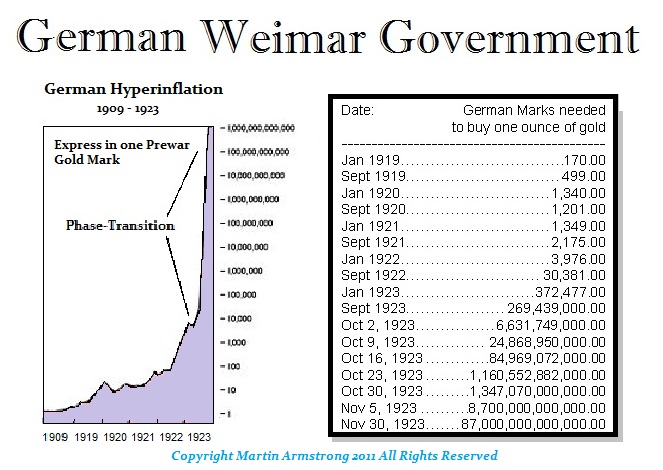Erich Maria Remarque, author of All Quiet on the Western Front, produced a novel in 1956 called The Black Obelisk about the nightmarish hyperinflation that battered the German mark in the early 1920’s and led to the rise of fascism. Germany’s experience during the troubled Weimar era, as detailed by Remarque, offers a frightening glimpse of what might well happen to this country in the years ahead.
Remarque’s novel describes a population that races breathlessly from Monday through Saturday to keep pace with inflation: “There’s no new dollar quotation Saturday afternoons. From noon [Saturday] till Monday morning our currency is stable.” (Note the importance of the “dollar quotation”. Already the US dollar had become the international currency of exchange.)
This is a world where those ruined by hyperinflation are “the people who have property they are forced to sell, small shopkeepers, day laborers, people with small incomes who see their bank accounts melting away, and government officials and employees who have to survive on salaries that no longer allow them to buy so much as a new pair of shoes. The ones who profit are the exchange kings, the profiteers, the foreigners who buy what they like with a few dollars, krone, or zlotys, and the big entrepreneurs and manufacturers, and the speculators on the exchange whose property and stocks increase without limit”.
Remarque’s protagonist Ludwig Bodmer is an embittered veteran of the trenches who resides in the fictional town of Werdenbrück, where he plays the piano for amusement and the organ for a local church and earns his living selling headstones for Heinrich Kroll and Sons, Funeral Monuments. He categorizes the firm’s inventory as follows: “cheap little headstones of sandstone and poured concrete with narrow pointed socles, for the poor, who live and slave in honesty and naturally get nowhere. . . . Next come the monuments of sandstone with inset plaques of marble, gray syenite, or black Swedish granite . . . for small businessmen, foremen, artisans who own their own businesses . . . ” Then come the larger polished monuments for “the more prosperous middle classes, the employer, the businessman, the larger store owner, and of course that diligent bird of ill omen, the higher official . . .” and finally there are elegant showpieces for “rich farmers, property owners, profiteers, and clever business people who deal in long-term promissory notes and so live on the Reichsbank, which keeps paying for everything with constantly replenished and unsupported paper currency”. Spouses and relatives of suicides are also frequent customers.
…click on the above link to read the rest of the article…























 ANSWER: Curious. I know that in Germany they do not really teach the details of the rise of Hitler. But he was the ultimate reaction to the events of the 1920s. There is a good book on the subject, but it is in German –
ANSWER: Curious. I know that in Germany they do not really teach the details of the rise of Hitler. But he was the ultimate reaction to the events of the 1920s. There is a good book on the subject, but it is in German – 

